PAA305 Advanced Financial Reporting: New Conceptual Framework Scope
VerifiedAdded on 2023/06/15
|14
|3917
|442
Report
AI Summary
This report critically examines the scope of the new conceptual framework for financial reporting, comparing it with the 1989 IASB framework. It discusses the background and objectives of financial reporting, underlying assumptions like harmonization and convergence, and qualitative characteristics including relevance, faithful representation, comparability, verifiability, timeliness, and understandability. The report also covers the elements of financial statements such as assets, liabilities, equity, income, and expenses, along with the concepts of financial and physical capital maintenance. Furthermore, it analyzes the arguments for and against the use of fair values in financial statement preparation and presentation, comparing fair value with historical cost measurements, highlighting their advantages and disadvantages. The report concludes by summarizing the key findings and implications of the analysis.
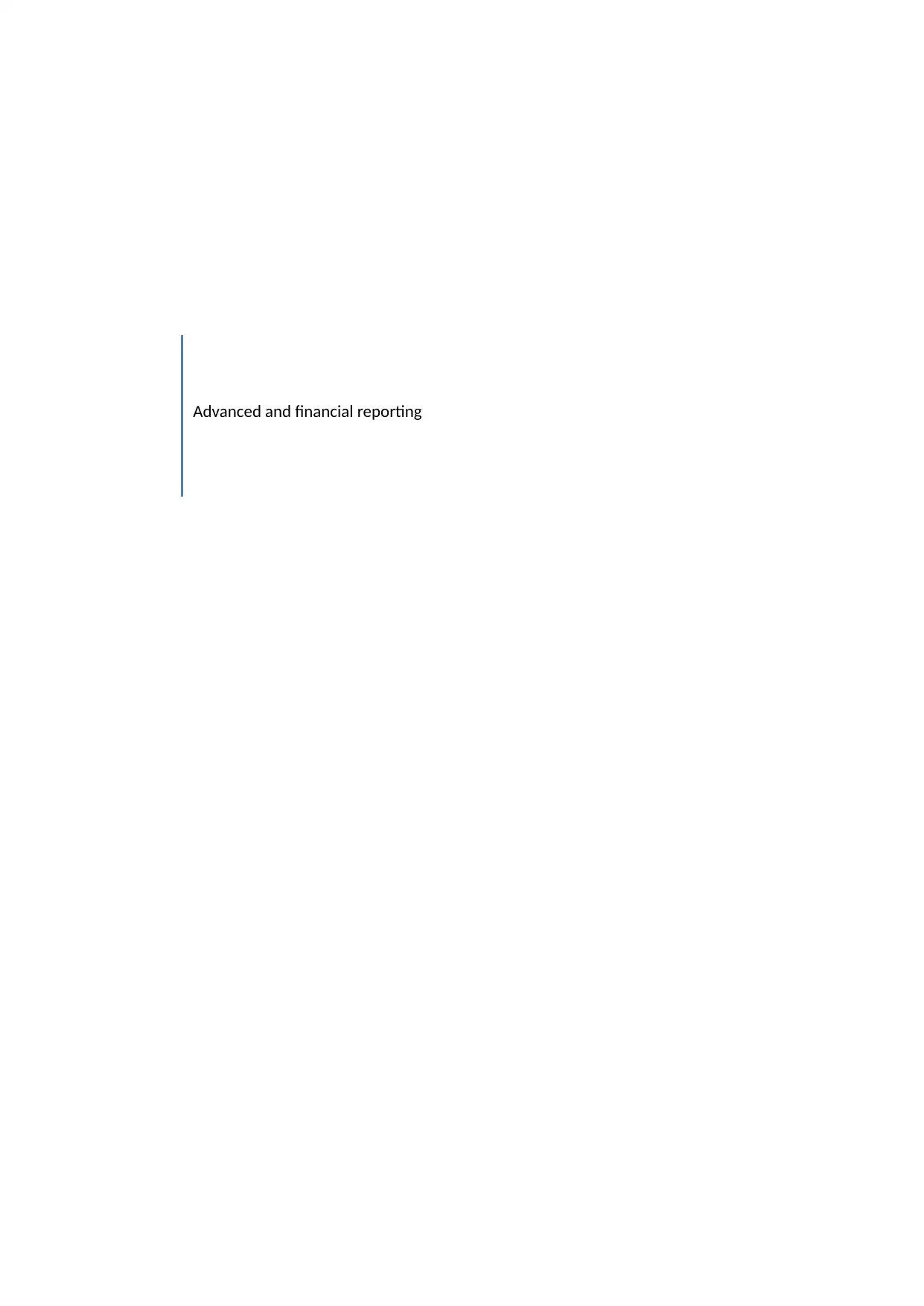
Advanced and financial reporting
Paraphrase This Document
Need a fresh take? Get an instant paraphrase of this document with our AI Paraphraser
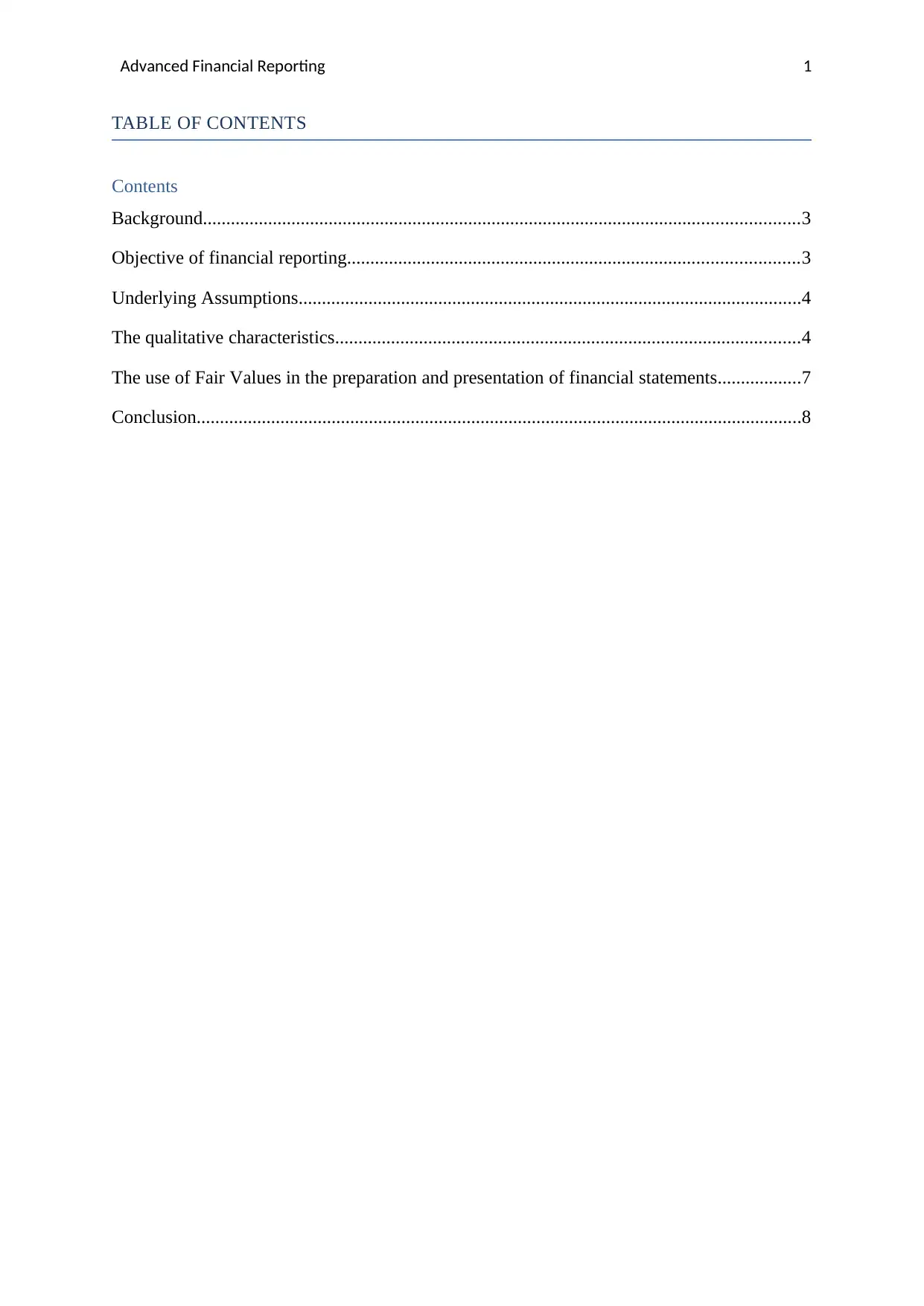
Advanced Financial Reporting 1
TABLE OF CONTENTS
Contents
Background................................................................................................................................3
Objective of financial reporting.................................................................................................3
Underlying Assumptions............................................................................................................4
The qualitative characteristics....................................................................................................4
The use of Fair Values in the preparation and presentation of financial statements..................7
Conclusion..................................................................................................................................8
TABLE OF CONTENTS
Contents
Background................................................................................................................................3
Objective of financial reporting.................................................................................................3
Underlying Assumptions............................................................................................................4
The qualitative characteristics....................................................................................................4
The use of Fair Values in the preparation and presentation of financial statements..................7
Conclusion..................................................................................................................................8
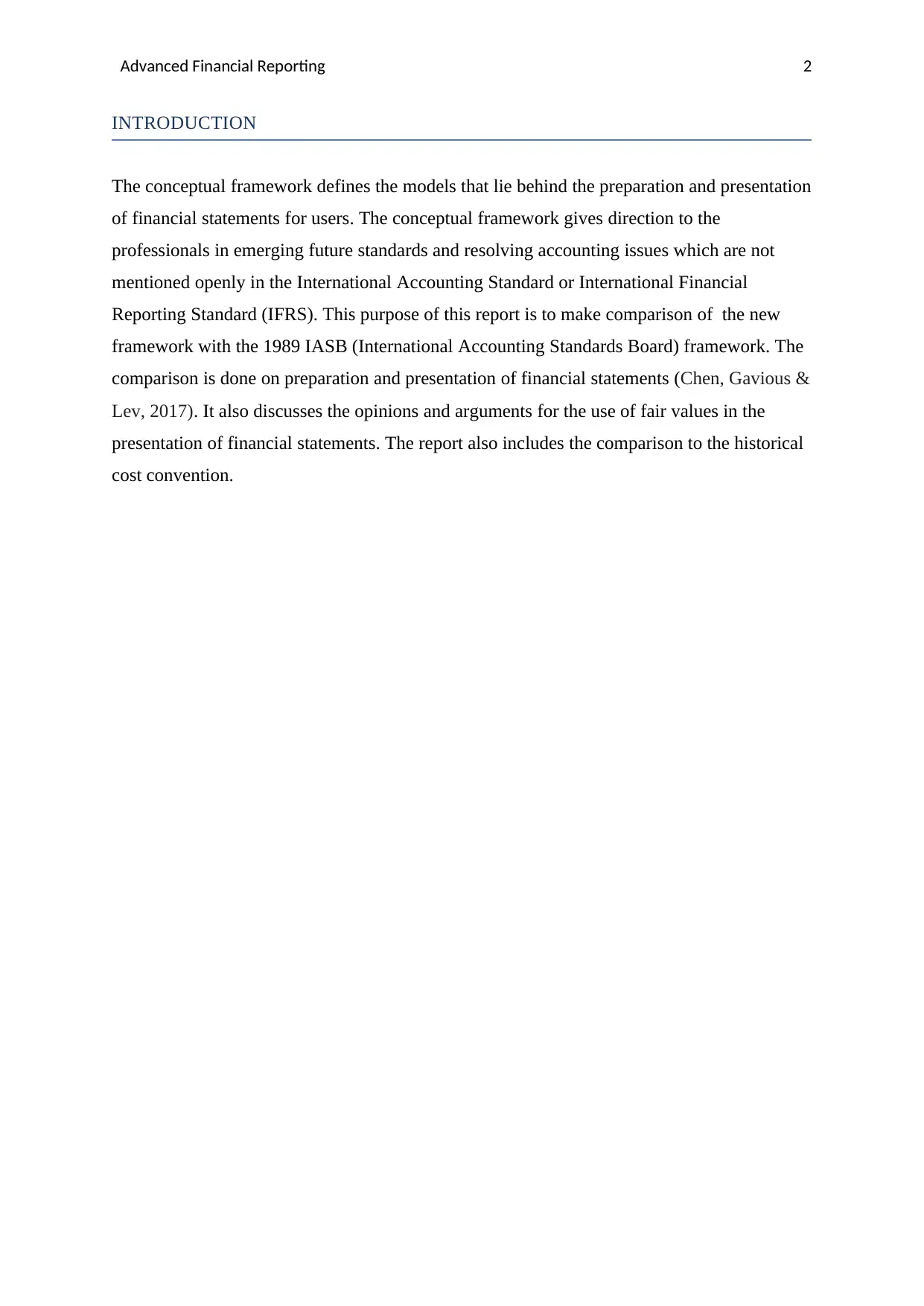
Advanced Financial Reporting 2
INTRODUCTION
The conceptual framework defines the models that lie behind the preparation and presentation
of financial statements for users. The conceptual framework gives direction to the
professionals in emerging future standards and resolving accounting issues which are not
mentioned openly in the International Accounting Standard or International Financial
Reporting Standard (IFRS). This purpose of this report is to make comparison of the new
framework with the 1989 IASB (International Accounting Standards Board) framework. The
comparison is done on preparation and presentation of financial statements (Chen, Gavious &
Lev, 2017). It also discusses the opinions and arguments for the use of fair values in the
presentation of financial statements. The report also includes the comparison to the historical
cost convention.
INTRODUCTION
The conceptual framework defines the models that lie behind the preparation and presentation
of financial statements for users. The conceptual framework gives direction to the
professionals in emerging future standards and resolving accounting issues which are not
mentioned openly in the International Accounting Standard or International Financial
Reporting Standard (IFRS). This purpose of this report is to make comparison of the new
framework with the 1989 IASB (International Accounting Standards Board) framework. The
comparison is done on preparation and presentation of financial statements (Chen, Gavious &
Lev, 2017). It also discusses the opinions and arguments for the use of fair values in the
presentation of financial statements. The report also includes the comparison to the historical
cost convention.
⊘ This is a preview!⊘
Do you want full access?
Subscribe today to unlock all pages.

Trusted by 1+ million students worldwide

Advanced Financial Reporting 3
The Conceptual Framework for Financial Reporting
Background
The conceptual framework has been left unchanged since it’s initiation in 1989. The IASB
and FASB revised conceptual framework in 2004. It was developed to provide direction to
users in preparation of financial reports and principles. It provides the concepts that can be
applied in emerging International Public Sector Accounting Standards (IPSAS). IPSAS are
established to apply in other countries and jurisdiction with different forms of government
(Christiaens, Vanhee, Manes-Rossi, Aversano & Van Cauwenberge, 2015). In 2011 the
conceptual framework was reactivated and finalised. It provides various open conceptual
issues which are faced in various current projects. So, IASB decided to add project to it’s
agenda in 2012. It focuses on the topics which are not yet covered such as presentation and
disclosure and shortcomings which are need to be improved other than the amendment of
framework. In the first step it covers all aspects of framework which were issued in 2013.
The purpose of conceptual frame work is to improve conceptual framework and provide base
for evolving future accounting standards. It also aims to serve direction to the board in
emerging future IFRS standards and address issues (Christensen, Lee, Walker & Zeng, 2015).
It also considers the definitions and measurement concepts such as income, expense assets
and liabilities in the IFRS framework.
Objective of financial reporting
The users of financial reporting are investors, lenders, creditors and prospective shareholders.
They make use of information for taking decisions like buying, selling or holding equity or
debentures. The users need information about future net cash inflows and resources of entity.
The general purpose financial reports do not provide data required by users to take economic
decisions. It is also needed to consider relevant information from other sources (Hoyle,
Schaefer & Doupnik, 2015).
The sensible parties and market controllers find general purpose financial reports more
useful. According to board the objective of financial reporting and objective of financial
regulations may not be constant. So, the controllers cannot be considered as main users. The
purpose of financial reports cannot be mainly directed to regulators. These are not considered
The Conceptual Framework for Financial Reporting
Background
The conceptual framework has been left unchanged since it’s initiation in 1989. The IASB
and FASB revised conceptual framework in 2004. It was developed to provide direction to
users in preparation of financial reports and principles. It provides the concepts that can be
applied in emerging International Public Sector Accounting Standards (IPSAS). IPSAS are
established to apply in other countries and jurisdiction with different forms of government
(Christiaens, Vanhee, Manes-Rossi, Aversano & Van Cauwenberge, 2015). In 2011 the
conceptual framework was reactivated and finalised. It provides various open conceptual
issues which are faced in various current projects. So, IASB decided to add project to it’s
agenda in 2012. It focuses on the topics which are not yet covered such as presentation and
disclosure and shortcomings which are need to be improved other than the amendment of
framework. In the first step it covers all aspects of framework which were issued in 2013.
The purpose of conceptual frame work is to improve conceptual framework and provide base
for evolving future accounting standards. It also aims to serve direction to the board in
emerging future IFRS standards and address issues (Christensen, Lee, Walker & Zeng, 2015).
It also considers the definitions and measurement concepts such as income, expense assets
and liabilities in the IFRS framework.
Objective of financial reporting
The users of financial reporting are investors, lenders, creditors and prospective shareholders.
They make use of information for taking decisions like buying, selling or holding equity or
debentures. The users need information about future net cash inflows and resources of entity.
The general purpose financial reports do not provide data required by users to take economic
decisions. It is also needed to consider relevant information from other sources (Hoyle,
Schaefer & Doupnik, 2015).
The sensible parties and market controllers find general purpose financial reports more
useful. According to board the objective of financial reporting and objective of financial
regulations may not be constant. So, the controllers cannot be considered as main users. The
purpose of financial reports cannot be mainly directed to regulators. These are not considered
Paraphrase This Document
Need a fresh take? Get an instant paraphrase of this document with our AI Paraphraser

Advanced Financial Reporting 4
to demonstrate the value of a reporting entity. It is also the objective of financial reporting to
provide relevant data to board of an organisation which can be used for planning, analysing
and decision making. In case of listed companies it provides information about various
aspects of organisation to the parties like shareholders and public. It also provides
information about the resources of organisation and how the resources have changed
overtime. It offers information how an organisation is using it’s various resources. It makes
available information to shareholders about performance of organisation and how it is
discharging fiduciary obligations and responsibilities (Davidson, Dey & Smith, 2015). It
enhances social welfare by taking care of interest of employees and trade union.
Underlying Assumptions
There are two underlying assumptions which are used for the preparation of financial
statements:
Harmonization: The term harmonization focuses on the minimising differences between
accounting standards. It is the process of increasing compatibility of accounting practices. It
can be done by reducing alternatives and differences in processes. The users want financial
information not only to be intellectual but comparable also so harmonisation is focussed
(Brusca, Caperchione, Cohen & Rossi, 2016). The lack of harmonization can put financial
burden on MNCs.
Convergence: Convergence is the process of coordinating accounting standards which are
issued by regulatory bodies. The objective of convergence is to produce common set of
accounting standards to enhance uniformity, comparability and effectiveness of accounting
standards (Davies & Hopt, 2013).
The similarity between harmonization and convergence is that both works on reducing
accounting principles and creating single set of accounting standards which are used in major
capital markets (Henderson, Peirson, Herbohn & Howieson, 2015). The difference between
harmonization and convergence is that harmonization focuses on GAAP along with IFRS
whereas convergence does not involve GAAP.
The qualitative characteristics
The revised framework extracts difference between the qualitative characteristics. These are
important in providing financial information:
to demonstrate the value of a reporting entity. It is also the objective of financial reporting to
provide relevant data to board of an organisation which can be used for planning, analysing
and decision making. In case of listed companies it provides information about various
aspects of organisation to the parties like shareholders and public. It also provides
information about the resources of organisation and how the resources have changed
overtime. It offers information how an organisation is using it’s various resources. It makes
available information to shareholders about performance of organisation and how it is
discharging fiduciary obligations and responsibilities (Davidson, Dey & Smith, 2015). It
enhances social welfare by taking care of interest of employees and trade union.
Underlying Assumptions
There are two underlying assumptions which are used for the preparation of financial
statements:
Harmonization: The term harmonization focuses on the minimising differences between
accounting standards. It is the process of increasing compatibility of accounting practices. It
can be done by reducing alternatives and differences in processes. The users want financial
information not only to be intellectual but comparable also so harmonisation is focussed
(Brusca, Caperchione, Cohen & Rossi, 2016). The lack of harmonization can put financial
burden on MNCs.
Convergence: Convergence is the process of coordinating accounting standards which are
issued by regulatory bodies. The objective of convergence is to produce common set of
accounting standards to enhance uniformity, comparability and effectiveness of accounting
standards (Davies & Hopt, 2013).
The similarity between harmonization and convergence is that both works on reducing
accounting principles and creating single set of accounting standards which are used in major
capital markets (Henderson, Peirson, Herbohn & Howieson, 2015). The difference between
harmonization and convergence is that harmonization focuses on GAAP along with IFRS
whereas convergence does not involve GAAP.
The qualitative characteristics
The revised framework extracts difference between the qualitative characteristics. These are
important in providing financial information:
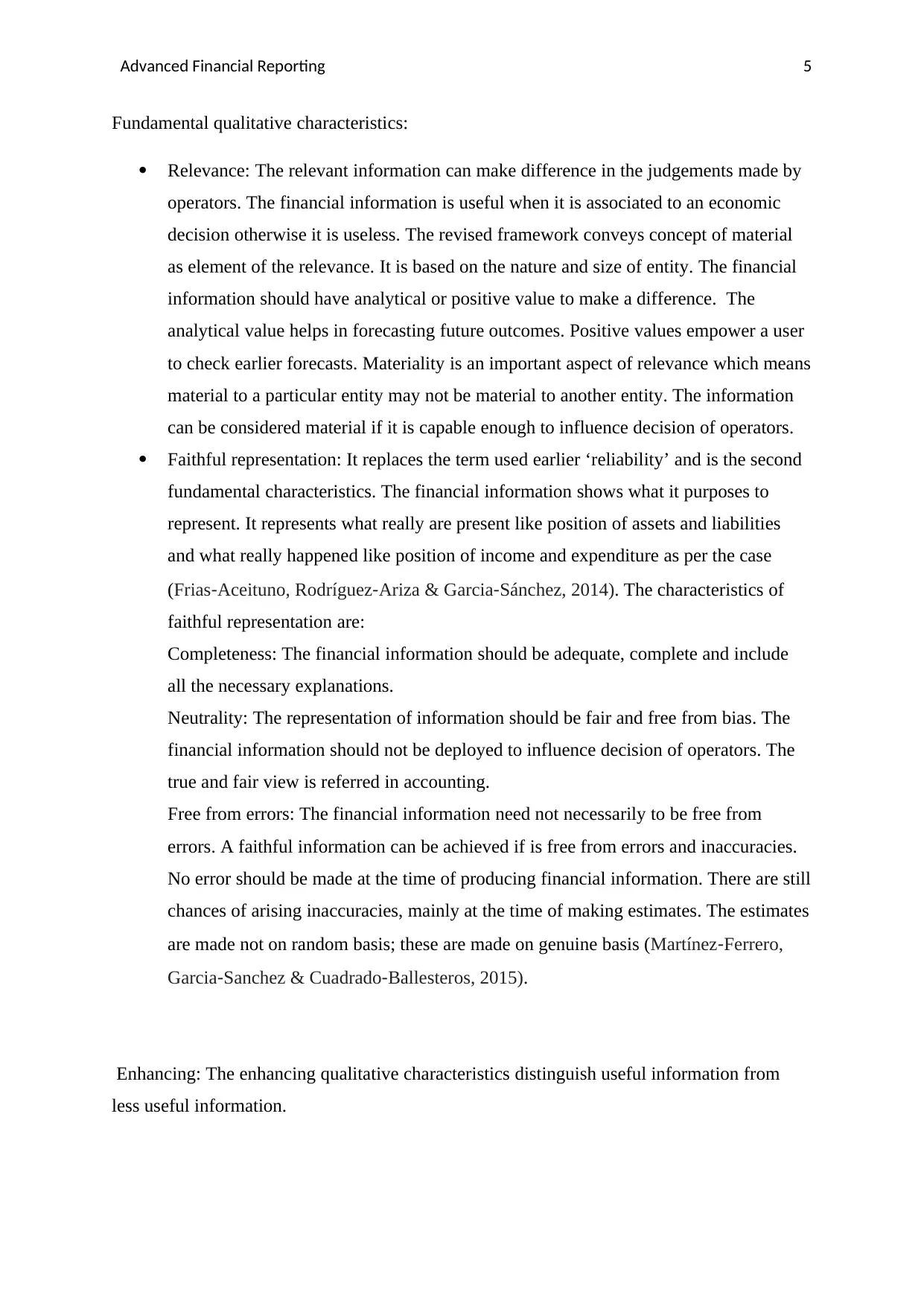
Advanced Financial Reporting 5
Fundamental qualitative characteristics:
Relevance: The relevant information can make difference in the judgements made by
operators. The financial information is useful when it is associated to an economic
decision otherwise it is useless. The revised framework conveys concept of material
as element of the relevance. It is based on the nature and size of entity. The financial
information should have analytical or positive value to make a difference. The
analytical value helps in forecasting future outcomes. Positive values empower a user
to check earlier forecasts. Materiality is an important aspect of relevance which means
material to a particular entity may not be material to another entity. The information
can be considered material if it is capable enough to influence decision of operators.
Faithful representation: It replaces the term used earlier ‘reliability’ and is the second
fundamental characteristics. The financial information shows what it purposes to
represent. It represents what really are present like position of assets and liabilities
and what really happened like position of income and expenditure as per the case
(Frias‐Aceituno, Rodríguez‐Ariza & Garcia‐Sánchez, 2014). The characteristics of
faithful representation are:
Completeness: The financial information should be adequate, complete and include
all the necessary explanations.
Neutrality: The representation of information should be fair and free from bias. The
financial information should not be deployed to influence decision of operators. The
true and fair view is referred in accounting.
Free from errors: The financial information need not necessarily to be free from
errors. A faithful information can be achieved if is free from errors and inaccuracies.
No error should be made at the time of producing financial information. There are still
chances of arising inaccuracies, mainly at the time of making estimates. The estimates
are made not on random basis; these are made on genuine basis (Martínez‐Ferrero,
Garcia‐Sanchez & Cuadrado‐Ballesteros, 2015).
Enhancing: The enhancing qualitative characteristics distinguish useful information from
less useful information.
Fundamental qualitative characteristics:
Relevance: The relevant information can make difference in the judgements made by
operators. The financial information is useful when it is associated to an economic
decision otherwise it is useless. The revised framework conveys concept of material
as element of the relevance. It is based on the nature and size of entity. The financial
information should have analytical or positive value to make a difference. The
analytical value helps in forecasting future outcomes. Positive values empower a user
to check earlier forecasts. Materiality is an important aspect of relevance which means
material to a particular entity may not be material to another entity. The information
can be considered material if it is capable enough to influence decision of operators.
Faithful representation: It replaces the term used earlier ‘reliability’ and is the second
fundamental characteristics. The financial information shows what it purposes to
represent. It represents what really are present like position of assets and liabilities
and what really happened like position of income and expenditure as per the case
(Frias‐Aceituno, Rodríguez‐Ariza & Garcia‐Sánchez, 2014). The characteristics of
faithful representation are:
Completeness: The financial information should be adequate, complete and include
all the necessary explanations.
Neutrality: The representation of information should be fair and free from bias. The
financial information should not be deployed to influence decision of operators. The
true and fair view is referred in accounting.
Free from errors: The financial information need not necessarily to be free from
errors. A faithful information can be achieved if is free from errors and inaccuracies.
No error should be made at the time of producing financial information. There are still
chances of arising inaccuracies, mainly at the time of making estimates. The estimates
are made not on random basis; these are made on genuine basis (Martínez‐Ferrero,
Garcia‐Sanchez & Cuadrado‐Ballesteros, 2015).
Enhancing: The enhancing qualitative characteristics distinguish useful information from
less useful information.
⊘ This is a preview!⊘
Do you want full access?
Subscribe today to unlock all pages.

Trusted by 1+ million students worldwide
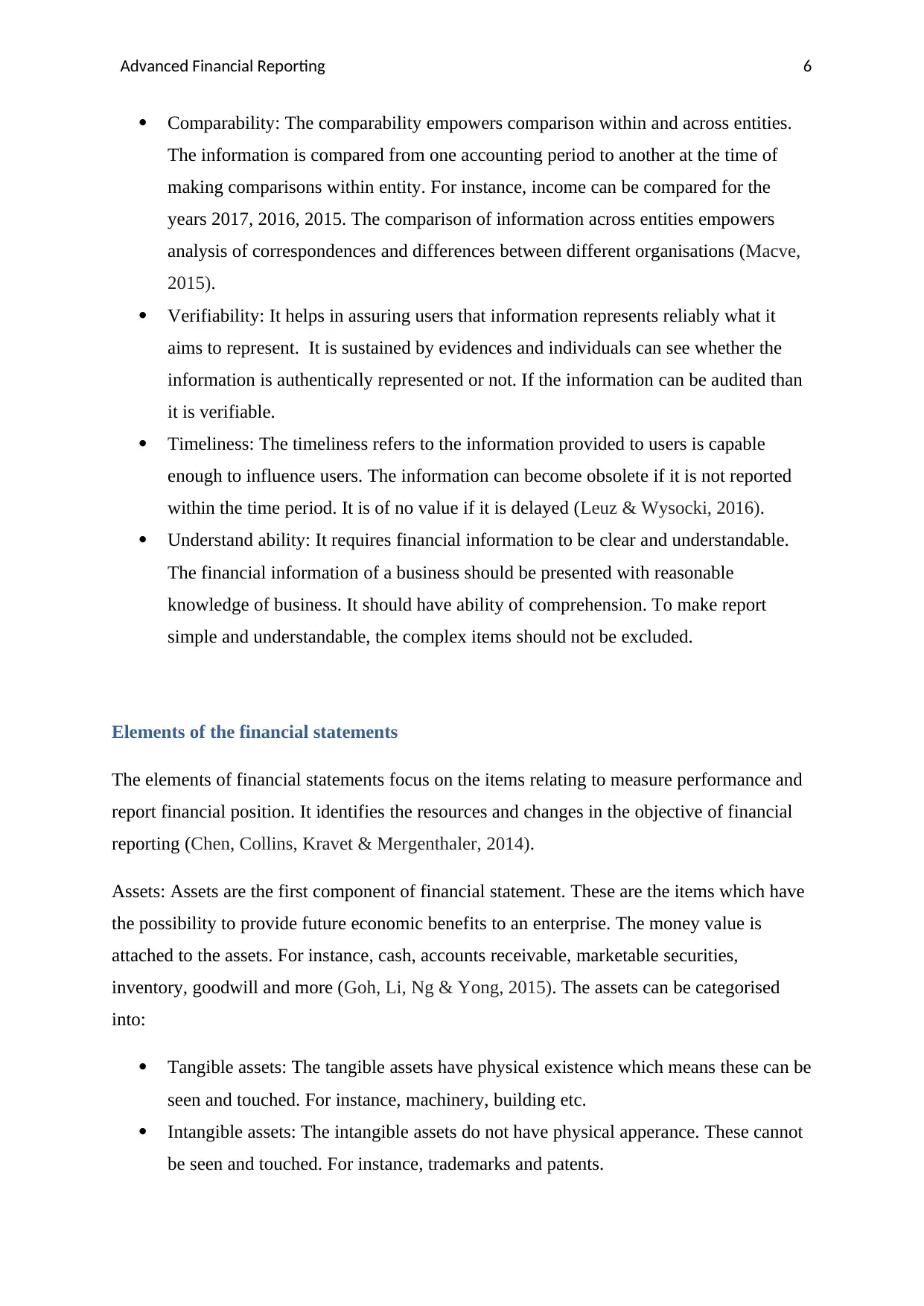
Advanced Financial Reporting 6
Comparability: The comparability empowers comparison within and across entities.
The information is compared from one accounting period to another at the time of
making comparisons within entity. For instance, income can be compared for the
years 2017, 2016, 2015. The comparison of information across entities empowers
analysis of correspondences and differences between different organisations (Macve,
2015).
Verifiability: It helps in assuring users that information represents reliably what it
aims to represent. It is sustained by evidences and individuals can see whether the
information is authentically represented or not. If the information can be audited than
it is verifiable.
Timeliness: The timeliness refers to the information provided to users is capable
enough to influence users. The information can become obsolete if it is not reported
within the time period. It is of no value if it is delayed (Leuz & Wysocki, 2016).
Understand ability: It requires financial information to be clear and understandable.
The financial information of a business should be presented with reasonable
knowledge of business. It should have ability of comprehension. To make report
simple and understandable, the complex items should not be excluded.
Elements of the financial statements
The elements of financial statements focus on the items relating to measure performance and
report financial position. It identifies the resources and changes in the objective of financial
reporting (Chen, Collins, Kravet & Mergenthaler, 2014).
Assets: Assets are the first component of financial statement. These are the items which have
the possibility to provide future economic benefits to an enterprise. The money value is
attached to the assets. For instance, cash, accounts receivable, marketable securities,
inventory, goodwill and more (Goh, Li, Ng & Yong, 2015). The assets can be categorised
into:
Tangible assets: The tangible assets have physical existence which means these can be
seen and touched. For instance, machinery, building etc.
Intangible assets: The intangible assets do not have physical apperance. These cannot
be seen and touched. For instance, trademarks and patents.
Comparability: The comparability empowers comparison within and across entities.
The information is compared from one accounting period to another at the time of
making comparisons within entity. For instance, income can be compared for the
years 2017, 2016, 2015. The comparison of information across entities empowers
analysis of correspondences and differences between different organisations (Macve,
2015).
Verifiability: It helps in assuring users that information represents reliably what it
aims to represent. It is sustained by evidences and individuals can see whether the
information is authentically represented or not. If the information can be audited than
it is verifiable.
Timeliness: The timeliness refers to the information provided to users is capable
enough to influence users. The information can become obsolete if it is not reported
within the time period. It is of no value if it is delayed (Leuz & Wysocki, 2016).
Understand ability: It requires financial information to be clear and understandable.
The financial information of a business should be presented with reasonable
knowledge of business. It should have ability of comprehension. To make report
simple and understandable, the complex items should not be excluded.
Elements of the financial statements
The elements of financial statements focus on the items relating to measure performance and
report financial position. It identifies the resources and changes in the objective of financial
reporting (Chen, Collins, Kravet & Mergenthaler, 2014).
Assets: Assets are the first component of financial statement. These are the items which have
the possibility to provide future economic benefits to an enterprise. The money value is
attached to the assets. For instance, cash, accounts receivable, marketable securities,
inventory, goodwill and more (Goh, Li, Ng & Yong, 2015). The assets can be categorised
into:
Tangible assets: The tangible assets have physical existence which means these can be
seen and touched. For instance, machinery, building etc.
Intangible assets: The intangible assets do not have physical apperance. These cannot
be seen and touched. For instance, trademarks and patents.
Paraphrase This Document
Need a fresh take? Get an instant paraphrase of this document with our AI Paraphraser
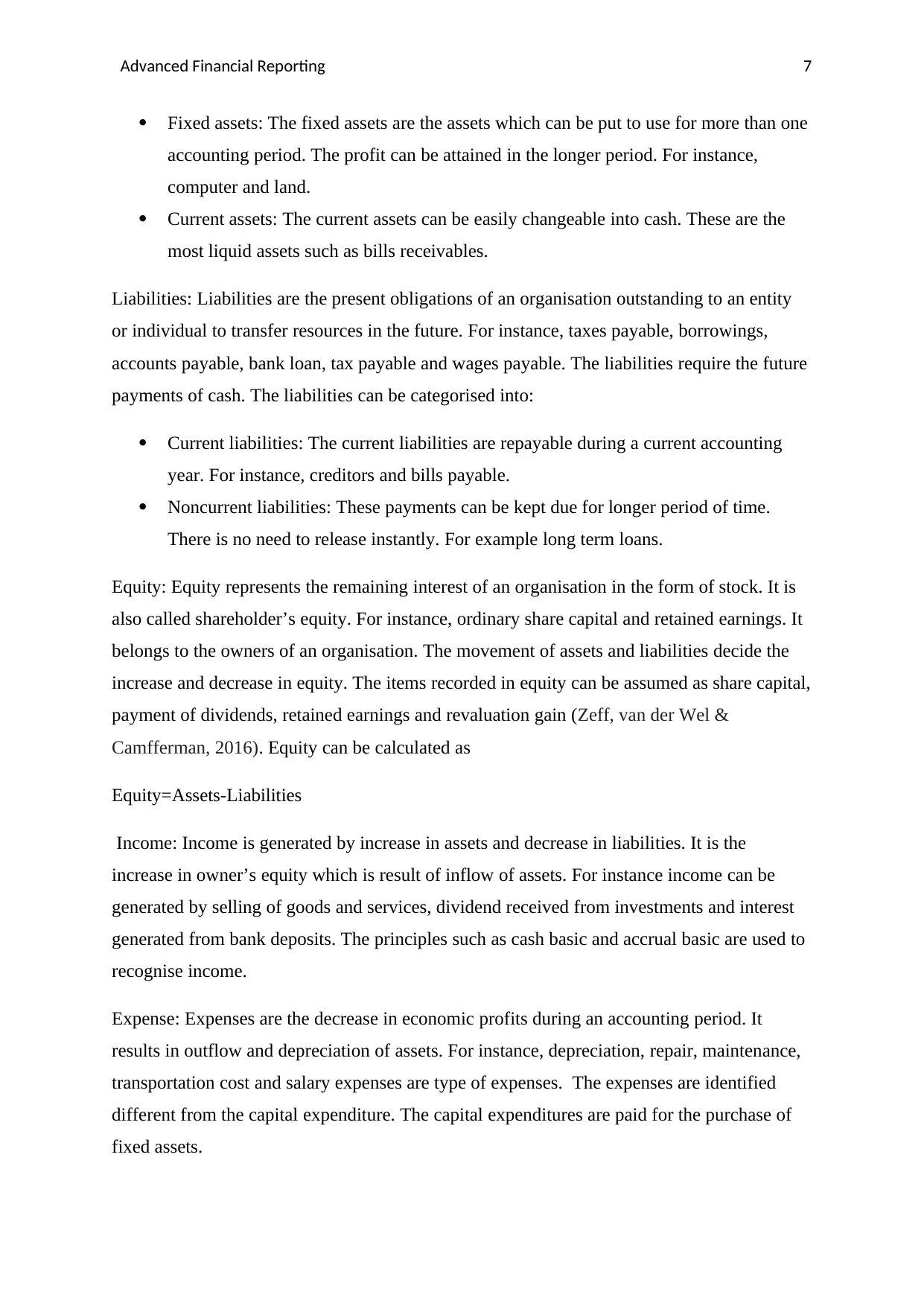
Advanced Financial Reporting 7
Fixed assets: The fixed assets are the assets which can be put to use for more than one
accounting period. The profit can be attained in the longer period. For instance,
computer and land.
Current assets: The current assets can be easily changeable into cash. These are the
most liquid assets such as bills receivables.
Liabilities: Liabilities are the present obligations of an organisation outstanding to an entity
or individual to transfer resources in the future. For instance, taxes payable, borrowings,
accounts payable, bank loan, tax payable and wages payable. The liabilities require the future
payments of cash. The liabilities can be categorised into:
Current liabilities: The current liabilities are repayable during a current accounting
year. For instance, creditors and bills payable.
Noncurrent liabilities: These payments can be kept due for longer period of time.
There is no need to release instantly. For example long term loans.
Equity: Equity represents the remaining interest of an organisation in the form of stock. It is
also called shareholder’s equity. For instance, ordinary share capital and retained earnings. It
belongs to the owners of an organisation. The movement of assets and liabilities decide the
increase and decrease in equity. The items recorded in equity can be assumed as share capital,
payment of dividends, retained earnings and revaluation gain (Zeff, van der Wel &
Camfferman, 2016). Equity can be calculated as
Equity=Assets-Liabilities
Income: Income is generated by increase in assets and decrease in liabilities. It is the
increase in owner’s equity which is result of inflow of assets. For instance income can be
generated by selling of goods and services, dividend received from investments and interest
generated from bank deposits. The principles such as cash basic and accrual basic are used to
recognise income.
Expense: Expenses are the decrease in economic profits during an accounting period. It
results in outflow and depreciation of assets. For instance, depreciation, repair, maintenance,
transportation cost and salary expenses are type of expenses. The expenses are identified
different from the capital expenditure. The capital expenditures are paid for the purchase of
fixed assets.
Fixed assets: The fixed assets are the assets which can be put to use for more than one
accounting period. The profit can be attained in the longer period. For instance,
computer and land.
Current assets: The current assets can be easily changeable into cash. These are the
most liquid assets such as bills receivables.
Liabilities: Liabilities are the present obligations of an organisation outstanding to an entity
or individual to transfer resources in the future. For instance, taxes payable, borrowings,
accounts payable, bank loan, tax payable and wages payable. The liabilities require the future
payments of cash. The liabilities can be categorised into:
Current liabilities: The current liabilities are repayable during a current accounting
year. For instance, creditors and bills payable.
Noncurrent liabilities: These payments can be kept due for longer period of time.
There is no need to release instantly. For example long term loans.
Equity: Equity represents the remaining interest of an organisation in the form of stock. It is
also called shareholder’s equity. For instance, ordinary share capital and retained earnings. It
belongs to the owners of an organisation. The movement of assets and liabilities decide the
increase and decrease in equity. The items recorded in equity can be assumed as share capital,
payment of dividends, retained earnings and revaluation gain (Zeff, van der Wel &
Camfferman, 2016). Equity can be calculated as
Equity=Assets-Liabilities
Income: Income is generated by increase in assets and decrease in liabilities. It is the
increase in owner’s equity which is result of inflow of assets. For instance income can be
generated by selling of goods and services, dividend received from investments and interest
generated from bank deposits. The principles such as cash basic and accrual basic are used to
recognise income.
Expense: Expenses are the decrease in economic profits during an accounting period. It
results in outflow and depreciation of assets. For instance, depreciation, repair, maintenance,
transportation cost and salary expenses are type of expenses. The expenses are identified
different from the capital expenditure. The capital expenditures are paid for the purchase of
fixed assets.
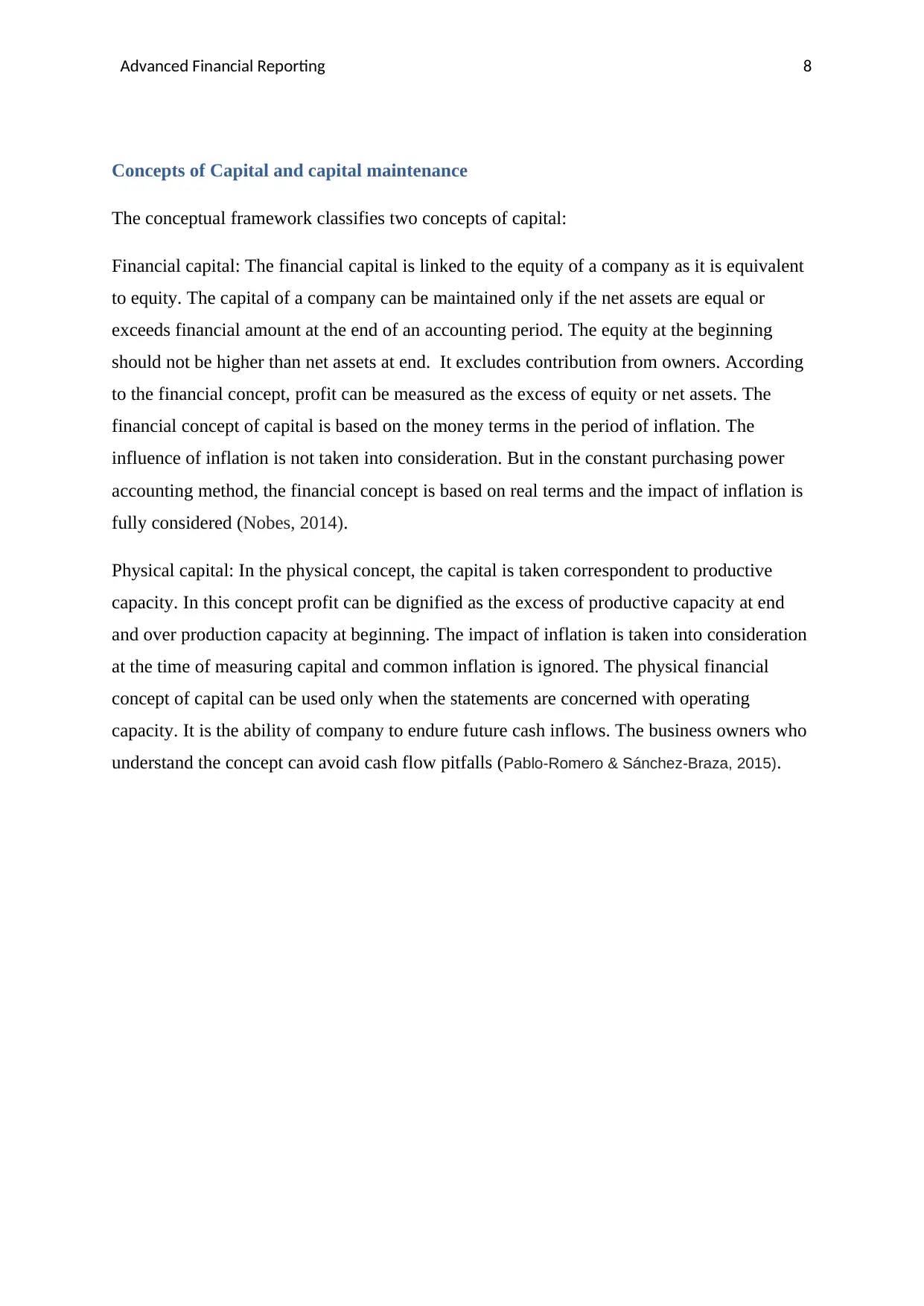
Advanced Financial Reporting 8
Concepts of Capital and capital maintenance
The conceptual framework classifies two concepts of capital:
Financial capital: The financial capital is linked to the equity of a company as it is equivalent
to equity. The capital of a company can be maintained only if the net assets are equal or
exceeds financial amount at the end of an accounting period. The equity at the beginning
should not be higher than net assets at end. It excludes contribution from owners. According
to the financial concept, profit can be measured as the excess of equity or net assets. The
financial concept of capital is based on the money terms in the period of inflation. The
influence of inflation is not taken into consideration. But in the constant purchasing power
accounting method, the financial concept is based on real terms and the impact of inflation is
fully considered (Nobes, 2014).
Physical capital: In the physical concept, the capital is taken correspondent to productive
capacity. In this concept profit can be dignified as the excess of productive capacity at end
and over production capacity at beginning. The impact of inflation is taken into consideration
at the time of measuring capital and common inflation is ignored. The physical financial
concept of capital can be used only when the statements are concerned with operating
capacity. It is the ability of company to endure future cash inflows. The business owners who
understand the concept can avoid cash flow pitfalls (Pablo-Romero & Sánchez-Braza, 2015).
Concepts of Capital and capital maintenance
The conceptual framework classifies two concepts of capital:
Financial capital: The financial capital is linked to the equity of a company as it is equivalent
to equity. The capital of a company can be maintained only if the net assets are equal or
exceeds financial amount at the end of an accounting period. The equity at the beginning
should not be higher than net assets at end. It excludes contribution from owners. According
to the financial concept, profit can be measured as the excess of equity or net assets. The
financial concept of capital is based on the money terms in the period of inflation. The
influence of inflation is not taken into consideration. But in the constant purchasing power
accounting method, the financial concept is based on real terms and the impact of inflation is
fully considered (Nobes, 2014).
Physical capital: In the physical concept, the capital is taken correspondent to productive
capacity. In this concept profit can be dignified as the excess of productive capacity at end
and over production capacity at beginning. The impact of inflation is taken into consideration
at the time of measuring capital and common inflation is ignored. The physical financial
concept of capital can be used only when the statements are concerned with operating
capacity. It is the ability of company to endure future cash inflows. The business owners who
understand the concept can avoid cash flow pitfalls (Pablo-Romero & Sánchez-Braza, 2015).
⊘ This is a preview!⊘
Do you want full access?
Subscribe today to unlock all pages.

Trusted by 1+ million students worldwide
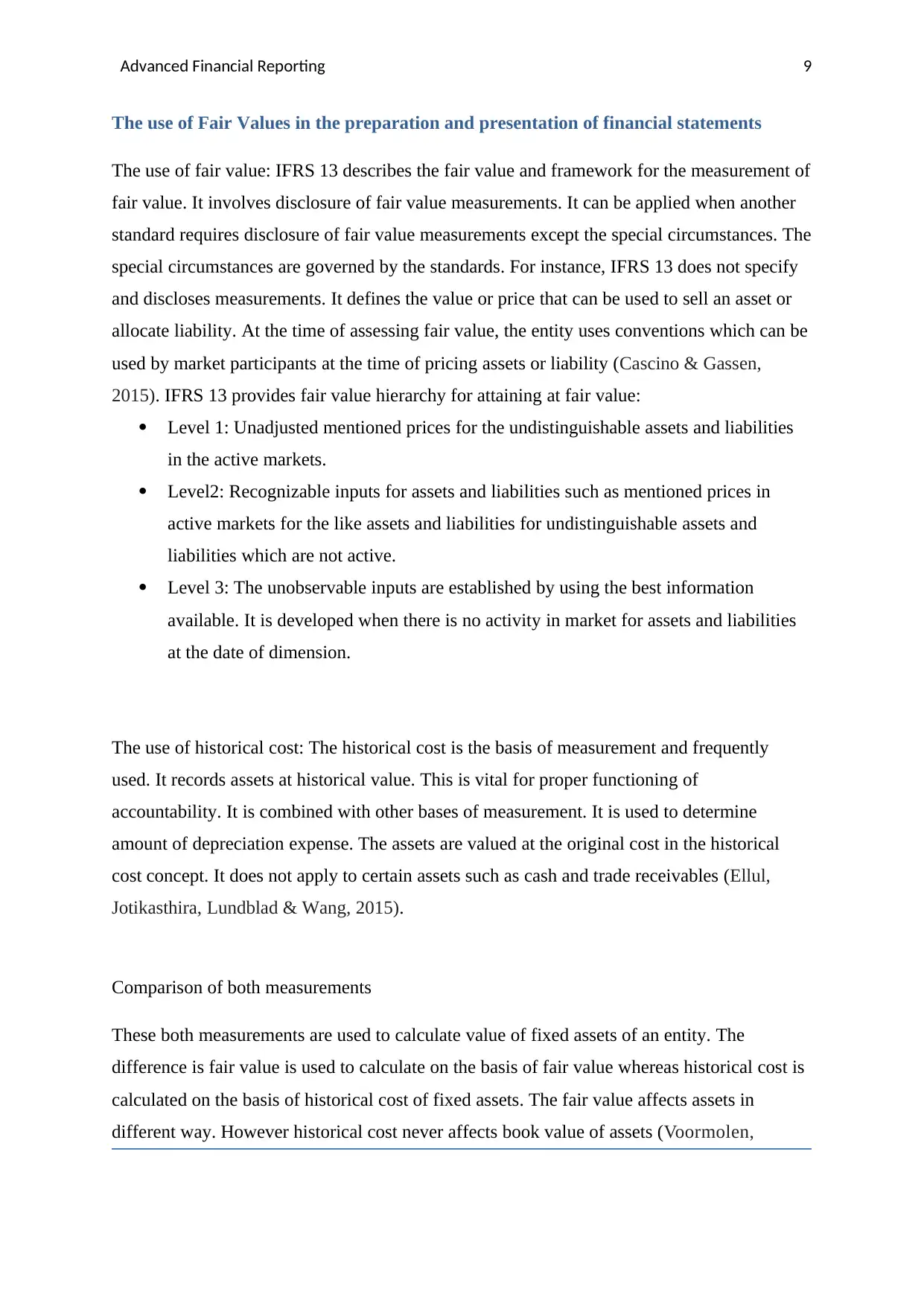
Advanced Financial Reporting 9
The use of Fair Values in the preparation and presentation of financial statements
The use of fair value: IFRS 13 describes the fair value and framework for the measurement of
fair value. It involves disclosure of fair value measurements. It can be applied when another
standard requires disclosure of fair value measurements except the special circumstances. The
special circumstances are governed by the standards. For instance, IFRS 13 does not specify
and discloses measurements. It defines the value or price that can be used to sell an asset or
allocate liability. At the time of assessing fair value, the entity uses conventions which can be
used by market participants at the time of pricing assets or liability (Cascino & Gassen,
2015). IFRS 13 provides fair value hierarchy for attaining at fair value:
Level 1: Unadjusted mentioned prices for the undistinguishable assets and liabilities
in the active markets.
Level2: Recognizable inputs for assets and liabilities such as mentioned prices in
active markets for the like assets and liabilities for undistinguishable assets and
liabilities which are not active.
Level 3: The unobservable inputs are established by using the best information
available. It is developed when there is no activity in market for assets and liabilities
at the date of dimension.
The use of historical cost: The historical cost is the basis of measurement and frequently
used. It records assets at historical value. This is vital for proper functioning of
accountability. It is combined with other bases of measurement. It is used to determine
amount of depreciation expense. The assets are valued at the original cost in the historical
cost concept. It does not apply to certain assets such as cash and trade receivables (Ellul,
Jotikasthira, Lundblad & Wang, 2015).
Comparison of both measurements
These both measurements are used to calculate value of fixed assets of an entity. The
difference is fair value is used to calculate on the basis of fair value whereas historical cost is
calculated on the basis of historical cost of fixed assets. The fair value affects assets in
different way. However historical cost never affects book value of assets (Voormolen,
The use of Fair Values in the preparation and presentation of financial statements
The use of fair value: IFRS 13 describes the fair value and framework for the measurement of
fair value. It involves disclosure of fair value measurements. It can be applied when another
standard requires disclosure of fair value measurements except the special circumstances. The
special circumstances are governed by the standards. For instance, IFRS 13 does not specify
and discloses measurements. It defines the value or price that can be used to sell an asset or
allocate liability. At the time of assessing fair value, the entity uses conventions which can be
used by market participants at the time of pricing assets or liability (Cascino & Gassen,
2015). IFRS 13 provides fair value hierarchy for attaining at fair value:
Level 1: Unadjusted mentioned prices for the undistinguishable assets and liabilities
in the active markets.
Level2: Recognizable inputs for assets and liabilities such as mentioned prices in
active markets for the like assets and liabilities for undistinguishable assets and
liabilities which are not active.
Level 3: The unobservable inputs are established by using the best information
available. It is developed when there is no activity in market for assets and liabilities
at the date of dimension.
The use of historical cost: The historical cost is the basis of measurement and frequently
used. It records assets at historical value. This is vital for proper functioning of
accountability. It is combined with other bases of measurement. It is used to determine
amount of depreciation expense. The assets are valued at the original cost in the historical
cost concept. It does not apply to certain assets such as cash and trade receivables (Ellul,
Jotikasthira, Lundblad & Wang, 2015).
Comparison of both measurements
These both measurements are used to calculate value of fixed assets of an entity. The
difference is fair value is used to calculate on the basis of fair value whereas historical cost is
calculated on the basis of historical cost of fixed assets. The fair value affects assets in
different way. However historical cost never affects book value of assets (Voormolen,
Paraphrase This Document
Need a fresh take? Get an instant paraphrase of this document with our AI Paraphraser
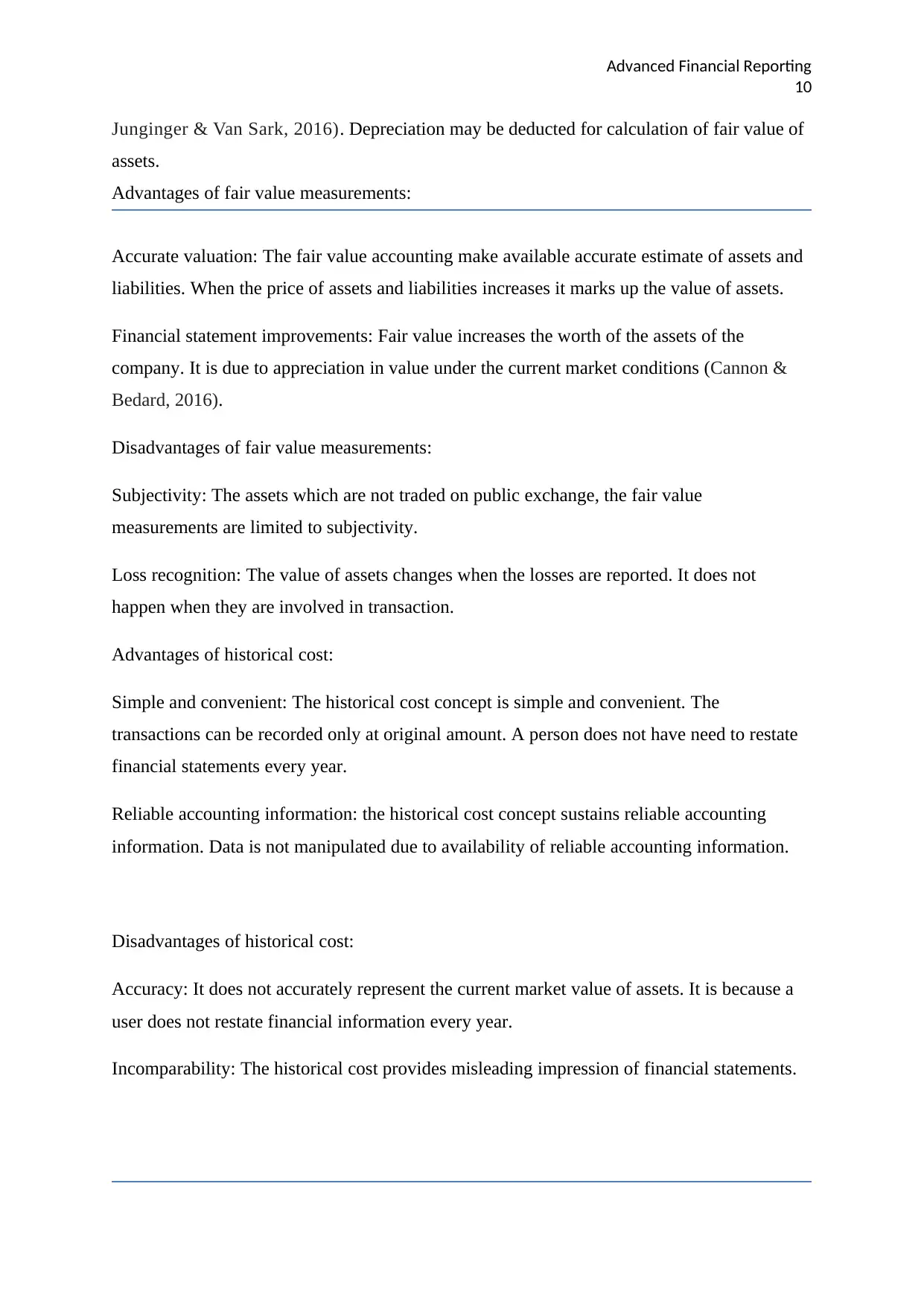
Advanced Financial Reporting
10
Junginger & Van Sark, 2016). Depreciation may be deducted for calculation of fair value of
assets.
Advantages of fair value measurements:
Accurate valuation: The fair value accounting make available accurate estimate of assets and
liabilities. When the price of assets and liabilities increases it marks up the value of assets.
Financial statement improvements: Fair value increases the worth of the assets of the
company. It is due to appreciation in value under the current market conditions (Cannon &
Bedard, 2016).
Disadvantages of fair value measurements:
Subjectivity: The assets which are not traded on public exchange, the fair value
measurements are limited to subjectivity.
Loss recognition: The value of assets changes when the losses are reported. It does not
happen when they are involved in transaction.
Advantages of historical cost:
Simple and convenient: The historical cost concept is simple and convenient. The
transactions can be recorded only at original amount. A person does not have need to restate
financial statements every year.
Reliable accounting information: the historical cost concept sustains reliable accounting
information. Data is not manipulated due to availability of reliable accounting information.
Disadvantages of historical cost:
Accuracy: It does not accurately represent the current market value of assets. It is because a
user does not restate financial information every year.
Incomparability: The historical cost provides misleading impression of financial statements.
10
Junginger & Van Sark, 2016). Depreciation may be deducted for calculation of fair value of
assets.
Advantages of fair value measurements:
Accurate valuation: The fair value accounting make available accurate estimate of assets and
liabilities. When the price of assets and liabilities increases it marks up the value of assets.
Financial statement improvements: Fair value increases the worth of the assets of the
company. It is due to appreciation in value under the current market conditions (Cannon &
Bedard, 2016).
Disadvantages of fair value measurements:
Subjectivity: The assets which are not traded on public exchange, the fair value
measurements are limited to subjectivity.
Loss recognition: The value of assets changes when the losses are reported. It does not
happen when they are involved in transaction.
Advantages of historical cost:
Simple and convenient: The historical cost concept is simple and convenient. The
transactions can be recorded only at original amount. A person does not have need to restate
financial statements every year.
Reliable accounting information: the historical cost concept sustains reliable accounting
information. Data is not manipulated due to availability of reliable accounting information.
Disadvantages of historical cost:
Accuracy: It does not accurately represent the current market value of assets. It is because a
user does not restate financial information every year.
Incomparability: The historical cost provides misleading impression of financial statements.

Advanced Financial Reporting
11
CONCLUSION
Conclusion
From the above report it can be concluded that the common conceptual framework makes a
significant commitment for the convergence of US and international accounting standards.
The framework develops future accounting standards. IFRS 13 has been defined which is
type of such standards. The background and objective of financial reporting has been
discussed to evaluate conceptual framework. The essential assumptions for the preparation of
financial statements have been discussed. Along with this qualitative characteristics and
elements of financial statements justifies conceptual framework. Further concepts of capital
and capital maintenance and use of fair values in preparation and presentation of financial
statements have been explained.
11
CONCLUSION
Conclusion
From the above report it can be concluded that the common conceptual framework makes a
significant commitment for the convergence of US and international accounting standards.
The framework develops future accounting standards. IFRS 13 has been defined which is
type of such standards. The background and objective of financial reporting has been
discussed to evaluate conceptual framework. The essential assumptions for the preparation of
financial statements have been discussed. Along with this qualitative characteristics and
elements of financial statements justifies conceptual framework. Further concepts of capital
and capital maintenance and use of fair values in preparation and presentation of financial
statements have been explained.
⊘ This is a preview!⊘
Do you want full access?
Subscribe today to unlock all pages.

Trusted by 1+ million students worldwide
1 out of 14
Related Documents
Your All-in-One AI-Powered Toolkit for Academic Success.
+13062052269
info@desklib.com
Available 24*7 on WhatsApp / Email
![[object Object]](/_next/static/media/star-bottom.7253800d.svg)
Unlock your academic potential
Copyright © 2020–2025 A2Z Services. All Rights Reserved. Developed and managed by ZUCOL.





